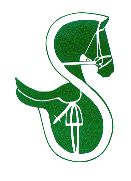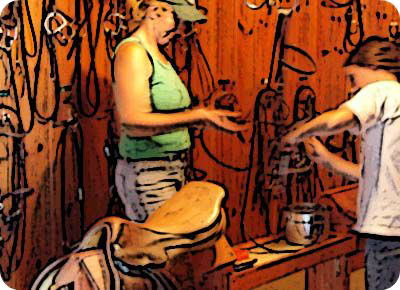 |
Sandridge Saddlery |
Basic Care of Equipment |
Franšais |

Stirrups
|
Stirrups: Stirrups can be cleaned by first rinsing off mud or brushing off any dried dirt, using a nailbrush or small vegetable brush to thoroughly clean the rubber or metal treads. On safety stirrups, ensure any hinges or springs are cleaned and periodically given a shot of WD-40 or a few drops of oil, and check any rubber areas for signs of weakness such as dryness or cracking. Stirrups made with metals other than stainless steel will require an occasional polishing with the appropriate metal polish to retain their shine. |
Saddle Pads
|
Cottons & Synthetics: Cotton quilt pads and synthetic fleece pads can be washed in the machine in warm water with a gentle detergent. To avoid shrinkage, either hang to dry or machine dry with low heat. Wool: Saddle pads with wool linings can also be machine washed in cold water on the gentle cycle with a soap designed for delicate fabrics. They should be hung to dry and the wool fluffed up by hand or with a stiff brush. Between washings, allow the pads to dry after riding with the wool side out and brush the wool before using it again to remove dirt and sweat and restore the pile. Sheepskin: Sheepskin pads are simply wool that is still on the leather skin. They should not be washed frequently as everytime the pad dries, the skin also dries out and becomes more fragile. Like wool-lined pads, sheepskin pads should be allowed to dry after use and then brushed to remove most of the dirt and sweat and to restore the pile. When washing is necessary, they can be put in the machine, gentle cycle, with a detergent designed for leather, suede, and delicate fabrics. Ten to fifteen minutes in the dryer on a 'no-heat' setting with a sheet of fabric softener seems to help keep the skin pliable; then hang the pad away from direct heat to finish drying. Neoprene and 'No-Slip' Pads: Neoprene pads can be brushed and/or hosed off to remove trapped hair, dirt and sweat and hung to dry, although it is normally safe to put them in the machine on a gentle cycle in warm water and then hang them to dry. ** The above are guidelines only - many pads come with washing instructions, and they should be followed for best results ** |
| Back to: Saddle Pads | Back to: Top of Page |
Blankets
|
Unlined Sheets: Most stable sheets and synthetic coolers can be washed in a regular machine on the gentle cycle in cold water. Shake or brush off any loose dirt and hair, close any buckles and velcro pieces before washing, and do not overload the machine to allow for thorough rinsing. Hang to dry. Lined Blankets: Once linings are involved, washing blankets becomes more of a challenge as they become heavier, bulkier, and the linings may shift. It is safer to use a large, front loading machine, again on the gentle cycle in cold water. Shake or brush off any loose dirt and hair, close any buckles and velcro pieces before washing, and do not overload the machine to allow for thorough rinsing. Hang to dry. Wool Coolers: Wool and wool-blend coolers and quarter sheets are best sent for dry-cleaning periodically. Though they can sometimes be washed gently in cold with a wool detergent, the risk of shrinkage is high. Waterproof Turnouts: While dirt and abrasion can reduce the effectiveness of the waterproof properties of blankets, detergents also compromise their ability to keep your horse dry. For longest life, hang up dirty, wet blankets to dry and brush off the dried dirt and hair before the next use. Rainsheets can be 'washed' on gentle in a machine without detergent to keep them fresh, or you can use a 'reproofing' product in the machine, and then hang the blanket to dry. Heavier turnouts should be left to the professionals. Again, regularly brush off dried dirt and hair, and prior to storage for the summer, send them to be professionally cleaned. Once turnouts start to lose their water-repellancy, you can treat them with a product (found in hardware or camping stores) to restore their effectiveness. ** The above are guidelines only - most blankets come with washing instructions, and they should be followed for best results ** |
| Back to: Blankets | Back to: Top of Page |